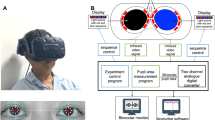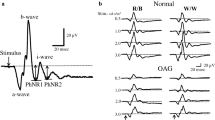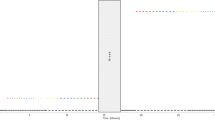Abstract
A perimetric method using blue stimuli on a yellow background was compared with perimetry using white stimulion on a white background as a method of detecting glaucomatous damage. Meridian perimetry was used with an adapted Tübinger perimeter. The difference between the blue-on-yellow meridian and the white-on-white meridian was subdivided into two parts: the general blue sensitivity loss (GBSL), probably due to optical factors, and the corrected blue sensitivity loss (CBSL), probably due to glaucoma. Nine normals, fourteen primary open angle glaucoma (POAG) patients and nine ocular hypertensives (OHT) were tested. All POAG patients and some of the OHT group showed higher CBSL values than the controls. The blue-yellow meridian showed broader and deeper defects than the white-white meridian in all of the POAG group; some of the OHT group had defects in the blue-yellow meridian that were not present in the white-white meridian.In conclusion, blue on yellow perimetry shows promise as a method for more sensitive detection of early glaucomatous damage.
Similar content being viewed by others
References
Abe H. Optic nerve damage and functional impairment in early glaucoma. Chibret Int Ophthal 1987; 5: 55–65.
Bone RA, Sparrock JMB. Comparison of macular pigment densities in human eyes. Vis Res 1971; 11: 1057–1064.
Breton ME, Krupin T. Age covariance between 100-Hue color scores and quantitative perimetry in primary open angle glaucoma. Arch Ophthal 1987; 105: 105–111.
De Monasterio FM. Asymmetry of on- and off-pathways of blue sensitive cones of the retina of macaques. Brain Res 1979; 166: 39–48.
De Monasterio FM, McCrane EP, Newlander JK, Schein SJ. Density profile of bluesensitive cones along the horizontal meridian of macaque retina. Invest Ophthal Vis Science 1985; 26: 289–302.
Drance SM. Early disturbances of color vision in chronic open angle glaucoma. Doc Ophthal Proc Ser 1981; 26: 155–159.
Drance SM. Acquired color vision changes in glaucoma. Arch Ophthalmol 1981; 99: 829–831.
Flammer J, Drance SM. Correlation between color vision scores and quantitative perimetry in suspected glaucoma. Arch Ophthal 1984; 102: 38–39.
Greenstein VC, Hood DC. A comparison of the S cone pathway sensitivity loss in patients with diabetes and retinitis pigmentosa. In: Color Vision Defeciencies IX. Drum B, Verriest G (eds). Dordrecht: Kluwer Academic Publishers 1989, 233–241.
Greenstein VC, Hood DC. S (blue) cone pathway vulnerability in retinitis pigmentosa, diabetes and glaucoma. Invest Ophthal Vis Sci 1989; 30: 1732–37.
Heagerstrom-Portnoy G, Hewlett SE, Barr SAN. S cone loss with aging. In: Color Vision Deficiencies IX. Drum B, Verriest G (eds). Dordrecht: Kluwer Academic Publishers, 1989, 345–352.
Hellman RL, Lynn JR. The effect of 4 asb and 31.5 asb background luminances in the detection and quantification of glaucomatous visual fields with a static automated perimeter. Invest Ophthal Vis Sci 1985; 26 (suppl): 225.
Heron G, Adams AJ. Central visual fields for short wavelength sensitive pathways in glaucoma and ocular hypertension. Invest Opththal Vis Sci 1988; 29: 64–72.
Johnson CA, Adams AJ. Automated perimetry of shorth-wavelength mechanisms in glaucoma and ocular hypertensives. In: Perimetry Update 1988/1989. Heijl E (ed). Kugler/Ghedini, 1988, 31–37.
King-Smith PE, Carden C. Luminance and opponent-color contributions to visual detection and adaptation and to temporal and spatial integration. J. Opt Soc Am 1976; 7: 709–717.
Krakau CET. Temporal summation and perimetry. Ophthalmic Res 1989; 21: 49–55.
Langerhorst CT. Automated Perimetry in Glaucoma (Thesis). Kugler/Ghedini, 1988.
Quigley HA, Dunkelberger GR. Retinal ganglion cell atrophy correlated with automated perimetry in human eyes with glaucoma. Am J Ophthal 1989; 107: 453–464.
Said FS, Weale RA. The variation with age of the spectral transmissivity of the living human crystalline lens. Gerontologia 1959; 3: 213–231.
Stiles WS. Color vision: An approach through increment threshold sensitivity. Proc Nat Acad Sci 1959; 45: 100–114.
Yeh T, Smith VC. The effect of the background luminance on cone sensitivity functions. Invest Ophthal Vis Sci 1989; 30: 2077–86.
Zrenner E, Gouras P. Characteristics of the blue sensitive cone mechanism in primate retinal ganglion cells. Vis Res 1981; 21: 1605–9.
Author information
Authors and Affiliations
Rights and permissions
About this article
Cite this article
De Jong, L.A.M.S., Snepvangers, C.E.J., Van Den Berg, T.J.T.P. et al. Blue-yellow perimetry in the detection of early glaucomatous damage. Doc Ophthalmol 75, 303–314 (1990). https://doi.org/10.1007/BF00164844
Accepted:
Issue Date:
DOI: https://doi.org/10.1007/BF00164844




